
The Automobil-Verkehrs- und Übungsstraße, known as AVUS, is a public road in Berlin, Germany. Opened in 1921, it was also used as a motor racing circuit until 1998. Today, the AVUS forms the northern part of the Bundesautobahn 115.
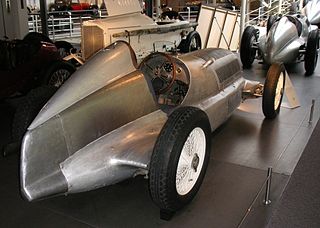
Silver Arrows is a nickname typically given to silver racing cars with a significant connection to a German car manufacturer. Although the term was coined in 1932, it came into popular usage regarding Germany's dominant Mercedes-Benz and Auto Union Grand Prix motor racing cars between 1934 and 1939. The name was later applied to the Mercedes-Benz Formula One and sports cars in 1954 and 1955, then to the Sauber Group C prototype racing sports cars that raced at Le Mans in the late 1980s as well as the McLaren-Mercedes Formula One cars of the late 1990s and 2000s, and is currently applied to the Mercedes-AMG Petronas F1 cars from 2010 to present.

Otto Wilhelm Rudolf Caracciola was a German racing driver. He won the European Drivers' Championship, the pre-1950 equivalent of the modern Formula One World Championship, an unsurpassed three times. He also won the European Hillclimbing Championship three times – twice in sports cars, and once in Grand Prix cars. Caracciola raced for Mercedes-Benz during their original dominating Silver Arrows period, named after the silver colour of the cars, and set speed records for the firm. He was affectionately dubbed Caratsch by the German public, and was known by the title of Regenmeister, or "Rainmaster", for his prowess in wet conditions.

Alfred Neubauer was the racing manager of the Mercedes-Benz Grand Prix team from 1926 to 1955.

Hans Erich Karl Josef Stuck was a German motor racing driver. Both his son Hans-Joachim Stuck and his grandsons Johannes and Ferdinand Stuck became race drivers.
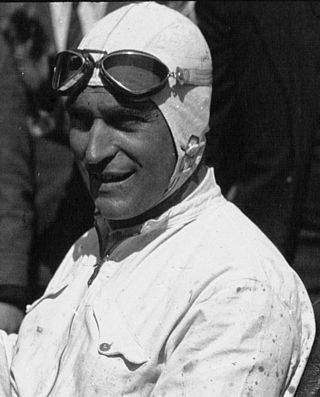
Luigi Cristiano Fagioli was an Italian racing driver, who competed in Grand Prix motor racing from 1928 to 1949, and Formula One from 1950 to 1951. Nicknamed "The Abruzzi Robber", Fagioli won the 1951 French Grand Prix with Alfa Romeo aged 53, and remains the oldest driver to win a Formula One Grand Prix. Fagioli was runner-up in the European Drivers' Championship in 1935 with Mercedes.

Philippe Jean Armand Étancelin was a French racing driver, and a winner of the 1934 24 Hours of Le Mans. He competed primarily on the Grand Prix circuit, and was an early Formula One driver.

The Mercedes-Benz W125 was a Grand Prix racing car produced by German auto manufacturer Mercedes-Benz to race during the 1937 Grand Prix season. Designed by head designer Rudolf Uhlenhaut, the car was used by Rudolf Caracciola to win the 1937 European Championship and W125 drivers also finished in the second, third and fourth positions in the championship.

Richard John Beattie Seaman was a British racing driver. He drove for the Mercedes-Benz team from 1937 to 1939 in the Mercedes-Benz W125 and W154 cars, winning the 1938 German Grand Prix. He died of his injuries after his car overturned at the 1939 Belgian Grand Prix.
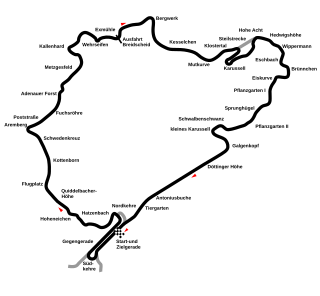
The 1935 German Grand Prix was a Grand Prix motor race held at the Nürburgring on 28 July 1935.
The Belgrade Grand Prix is a former grand prix from the Grand Prix motor racing era - precursor to Formula One. It was held on the streets of Belgrade, the capital of Kingdom of Yugoslavia and Serbia's largest city. Only one championship event was held, on 3 September 1939. This race saw 5 drivers take part - two Mercedes-Benz in their Silver Arrows, two Auto Unions and a Bugatti, which finished 19 laps down - and was won by Tazio Nuvolari. The Kalemegdan Park circuit is no longer operational.

The Alfa Romeo P3, P3 monoposto or Tipo B was a classic Grand Prix car designed by Vittorio Jano, one of the Alfa Romeo 8C models. The P3 is considered to be the world's first genuine single-seat Grand Prix racing car and was Alfa Romeo's second monoposto after the Tipo A monoposto (1931). It was based on the earlier successful Alfa Romeo P2. Taking lessons learned from that car, Jano went back to the drawing board to design a car that could last longer race distances.
Throughout its long history, Mercedes-Benz has been involved in a range of successful motorsport activities, including sportscar racing, touring car racing, Grand Prix racing, and rallying. It is currently active in GT racing, and Formula One. Mercedes is also one of only three constructors to complete the Triple Crown of Motorsport, a feat that Mercedes achieved as both a chassis manufacturer and an engine manufacturer by winning the 1952 24 Hours of Le Mans.
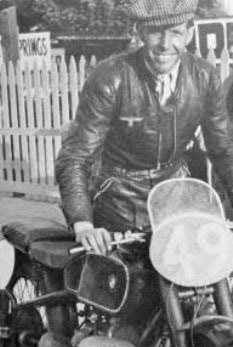
Georg "Schorsch" Meier was a German motorcycle racer famous for being the first foreign winner of the prestigious Senior TT, the Blue Riband race of the Isle of Man TT Races, in 1939 riding for the factory BMW team and the first motorcycle racer to lap a Grand Prix course at over 100 mph.

The 1935 Grand Prix season was the second year of the new 750 kg Formula. The success of the previous year encouraged the AIACR to reinitiate the European Championship. It was composed of the seven national Grands Prix and was won by Rudolf Caracciola, driving for the Mercedes-Benz team. The team dominated the season winning five of those Grand Épreuves, as well as four of the other major races of the season. However, in one of the great motor-races in sporting history, Tazio Nuvolari in a Scuderia Ferrari Alfa Romeo beat the combined numbers of the German teams in their home Grand Prix. The season also saw the arrival on the international stage of the bright young talent Bernd Rosemeyer in the Auto Union team.
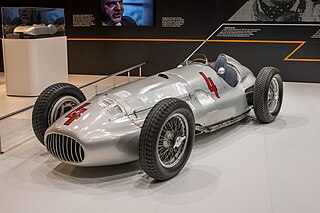
The Mercedes-Benz W154 was a Grand Prix racing car designed by Rudolf Uhlenhaut. The W154 competed in the 1938 and 1939 Grand Prix seasons and was used by Rudolf Caracciola to win the 1938 European Championship.

The Auto Union Grand Prix racing cars types A to D were developed and built by a specialist racing department of Auto Union's Horch works in Zwickau, Germany, between 1933 and 1939, after the company bought a design by Dr. Ferdinand Porsche in 1933. The Auto Union type B streamlined body was designed by Paul Jaray.
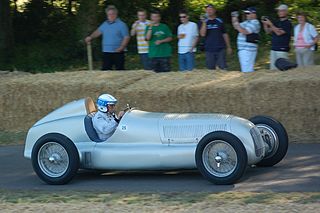
The Mercedes-Benz W25 was a Grand Prix racing car designed by Daimler-Benz AG for the 1934 Grand Prix season, in which new rules were introduced, and no championship was held. In 1935, the European Championship was resumed, and it was won by Rudolf Caracciola in a W25. In modified form, the W25 remained in use until 1937, when it was succeeded by the Mercedes-Benz W125.

Otto Merz was a German racing driver, chauffeur and mechanic. He was a driver in the motorcade during the 1914 assassination of Archuduke Franz Ferdinand and later won the second running of the German Grand Prix in 1927. He died in a crash during practice for the 1933 Avusrennen in a modified Mercedes SSK on 18 May 1933.

August "Bubi" Momberger was a German racing driver and engineer, who competed in Grand Prix motor racing events for various manufacturers between 1926 and 1934. During the 1934 Grand Prix season – the first season of the infamous Silver Arrows period of German dominance of Grand Prix racing, that would last until the outbreak of WWII – he drove for the Auto Union Rennabteilung, and was the first driver of a Silver Arrows car to take a podium finish in a major race. During the season he took a further second-placed finish, and posted two fastest laps, but worsening arthritis and a deteriorating relationship with the Auto Union team manager forced him into retirement before the end of the year. Following his retirement from racing, Momberger returned to his engineering training and rose steadily through the ranks of the German automobile industry, eventually becoming technical director of the Borgward company's Goliath division in Bremen.



















